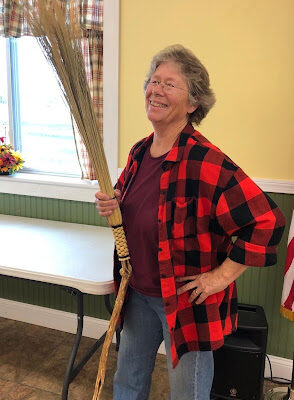
Milo Garden Club learns about handcrafted brooms
MILO — On Oct. 14 Milo Garden Club enjoyed a fascinating program presented by craftsperson Laura Kneib. Among a colorful display of her own handmade brooms, she shared a brief history of brooms mentioning that their earliest known use dates back 2,000 years.
Kneib described the different grasses, twigs, types of binding and stick variety used in making brooms. In the 1700s, early birch growth was gathered in the spring and bound tightly. Finally, a thick stick was stuck down the middle of the bundle.
Up until the time of the Shakers, brooms were round. An innovative member of this group realized a squared, flattened broom would prove much more efficient.

HANDCRAFTED — Laura Kneib displays one of the brooms she handcrafted.
Using one of her brooms with an elegant sweep of Sorghum straw and a lovely, long and curled honeysuckle stick, Kneib swept the upper wall and ceiling corner of the room to illustrate how this broom was perfect for eliminating cobwebs.
Other examples of these longer brooms also had handles of naturally twisted wood. Kneib called these “riding brooms.” Many years ago, when women, known as Alewives, brewed beer, herbs and spices were added for flavor. Henbane was one of them. When drinkers became intoxicated by the beer, their blurry vision confused the Alewives for women riding brooms suggesting the idea of flying witches. A very appropriate piece of knowledge for the Milo Garden Club’s October meeting.
Please consider visiting or joining Milo Garden Club. The next meeting is Tuesday, Nov. 18 at 1 p.m. at the Kiwanis Building, 15 Harris Pond Road. The program is a Pig-In-A-Poke auction to raise money for Dyer’s Hope House Food Cupboard. Attendees are invited to join in the fun by bringing in an inexpensive wrapped gift to be auctioned off to the highest bidder.
For more information, please call 207-943-2400.